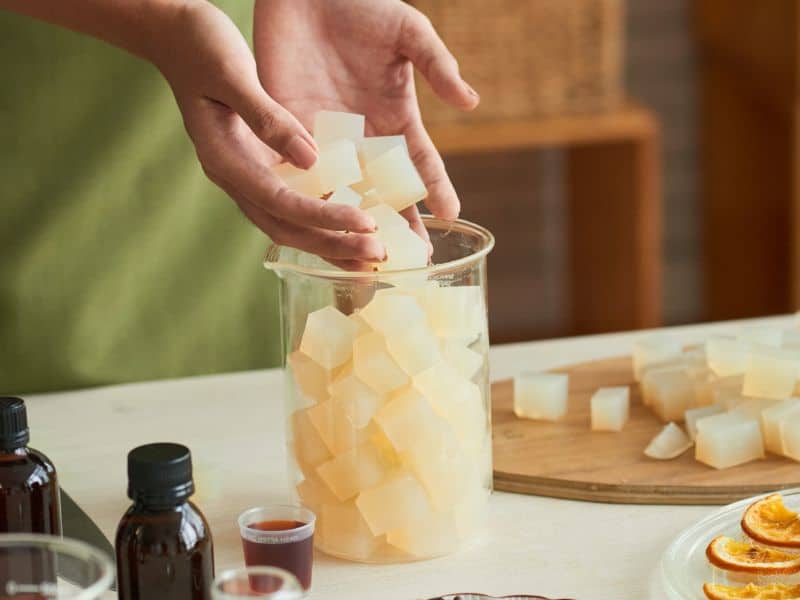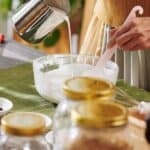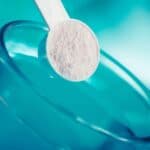Are you considering making handmade soaps? If so, you may be wondering if preservatives are necessary. In this article, we will discuss preservatives and if they are necessary for your homemade soaps and some other details that you need to know.
Handmade soaps do not need preservatives, as the high pH and low water content discourage bacterial growth. However, if the soap contains additives like herbs, fruit, or milk, a preservative may be necessary to prevent spoilage and mold.
When adding a preservative, it’s important to look for one that is not only safe but also effective at preventing bacteria and fungi from growing. In addition, it is important to note that some natural ingredients may have preservative properties, such as essential oils.
Understanding Preservatives
Definition and Purpose of Preservatives
Preservatives are substances added to products, including handmade soaps, to prevent or slow down the growth of microbes such as bacteria, mold, and yeast. This helps to prolong the shelf life of the product, maintain its quality, and ensure its safety for the consumer.
Types of Preservatives Commonly Used in Soap Making
Synthetic preservatives
Some examples of synthetic preservatives used in soap making include parabens, phenoxyethanol, and formaldehyde-releasing agents.
These preservatives are effective at inhibiting microbial growth but have been associated with potential health concerns.
Natural preservatives
Natural preservatives, such as grapefruit seed extract, rosemary oleoresin extract, and essential oils with antimicrobial properties, are gaining popularity as more consumers seek eco-friendly and non-toxic alternatives.
While they can be effective, their performance may not be as consistent as synthetic preservatives.
Pros and Cons of Using Preservatives in Handmade Soaps
Pros:
- Extends the shelf life of handmade soaps
- Prevents microbial growth, ensuring product safety
- Reduces potential for skin irritation and infection from contaminated soap
Cons:
- Synthetic preservatives may have potential health risks
- Natural preservatives may not be as consistently effective
- Some consumers may have allergies or sensitivities to preservatives
Factors that Affect the Need for Preservatives in Handmade Soaps
Ingredients Used in Soap Making
- Oils and butters
- The type and quality of oils and butters used in soap making can affect the soap’s shelf life. Rancidity-prone oils may require antioxidants, such as vitamin E, to prevent spoilage, while others may not need any additional preservation.
- Liquid components
- The use of liquids like milk, fruit juice, or aloe vera juice can introduce additional moisture and nutrients for microbial growth, potentially necessitating the use of a preservative.
- Additives
- Certain additives, like sugar, honey, or botanicals, can provide a food source for microbes, increasing the need for preservatives in handmade soaps.
Soap-Making Process
- Cold process
- Cold process soaps have a high pH level, which naturally inhibits microbial growth. However, the addition of certain ingredients may still require the use of preservatives.
- Hot process
- Hot process soaps also have a high pH level, but the cooking process can help to eliminate any existing bacteria or mold. The need for preservatives will depend on the specific ingredients used.
- Melt and pour
- Melt and pour soaps often have lower pH levels and may contain additional water content, increasing the likelihood of microbial growth and the need for preservatives.
Environmental Factors
- Humidity
- High humidity can increase the moisture content in handmade soaps, promoting microbial growth and potentially necessitating the use of preservatives.
- Temperature
- Fluctuating temperatures can affect the stability and shelf life of handmade soaps. Preservatives may be needed to ensure the soap remains safe and effective under various conditions.
- Storage conditions
- Proper storage, such as keeping soaps in a cool, dry, and dark environment, can help to minimize the need for preservatives. However, if soaps are exposed to adverse conditions, preservatives may be necessary to maintain their quality and safety.
The Role of Soap pH and its Effect on Preservative Needs
The importance of pH in handmade soaps
The pH level of handmade soaps plays a crucial role in their overall quality and safety. A high pH level (alkaline) is characteristic of soap, which is naturally antimicrobial. This is primarily due to the saponification process, where oils and fats react with an alkali, such as sodium hydroxide or potassium hydroxide, to form soap. A soap’s pH not only affects its ability to clean but also influences the growth of microbes on its surface and within its matrix.
How pH affects the growth of microbes
Microbes, such as bacteria, fungi, and yeast, generally prefer a neutral to mildly acidic environment for optimal growth. The high alkalinity of soap creates an inhospitable environment for most microbes, inhibiting their growth and multiplication. However, certain ingredients, additives, or environmental factors can lower the soap’s pH level, making it more susceptible to microbial contamination.
Adjusting pH levels to minimize the need for preservatives
While it is not always possible or desirable to alter a soap’s pH level significantly, some strategies can help maintain a pH that is less conducive to microbial growth.
These may include:
- Selecting oils and fats with a naturally higher pH
- Avoiding the use of acidic additives, such as fruit juices or vinegar
- Ensuring proper curing and drying of soaps to reduce the moisture content
By maintaining a high pH level, soap makers can potentially minimize the need for preservatives in their products.
Guidelines for Deciding Whether to Use Preservatives in Handmade Soaps
Assessing the risk of microbial growth
To determine the necessity of using preservatives in handmade soaps, it is essential to evaluate the risk of microbial growth.
Consider the following factors:
- The ingredients used in the soap, including oils, liquids, and additives
- The soap-making process employed (cold process, hot process, or melt and pour)
- The environmental conditions under which the soap will be stored and used
Considering the shelf life and intended use of the soap
Another factor to consider when deciding whether to use preservatives is the intended shelf life and use of the soap.
For instance:
- If the soap is intended for personal use and will be consumed within a short period, preservatives may not be necessary.
- Soaps intended for sale or gifting may require preservatives to ensure safety and quality during transportation, storage, and usage.
Balancing consumer preferences and product safety
Incorporating preservatives in handmade soaps involves striking a balance between consumer preferences and product safety.
Soap makers should:
- Be aware of the potential health concerns associated with synthetic preservatives and consider using natural alternatives.
- Educate customers about the purpose of preservatives in ensuring product safety and quality.
- Listen to consumer feedback and adapt their formulations accordingly.
By carefully evaluating these factors and balancing consumer preferences with product safety, soap makers can make informed choices regarding the use of preservatives in their creations.
Alternatives to Traditional Preservatives
While preservatives play a crucial role in maintaining the quality and safety of some homemade soaps, there are alternatives and best practices that can help minimize their necessity.
Antioxidants to prolong shelf life
Antioxidants, such as vitamin E or rosemary oleoresin extract (ROE), can help prolong the shelf life of homemade soaps by preventing the oxidation of oils and fats, which can lead to rancidity. Although antioxidants do not have the same antimicrobial properties as preservatives, they can still contribute to the overall stability and quality of the soap by protecting the oils from spoilage.
To use antioxidants in homemade soap:
- Select an appropriate antioxidant based on its compatibility with the soap’s ingredients.
- Add the antioxidant at the recommended usage rate during the soap-making process, typically in the oil phase or after trace.
- Ensure proper mixing and distribution of the antioxidant throughout the soap.
Proper soap storage and handling practices
By implementing proper storage and handling practices, soap makers can minimize the need for preservatives in their homemade soaps.
Some guidelines include:
- Store soaps in a cool, dry, and well-ventilated area away from direct sunlight and heat sources.
- Use clean and dry hands or utensils when handling soaps to prevent contamination.
- Allow soaps to cure for the recommended time to ensure that excess moisture evaporates, creating a harder, longer-lasting bar.
- Package and store soaps individually to prevent cross-contamination.
Educating customers on soap care and maintenance
Another crucial aspect of minimizing the need for preservatives in homemade soaps is educating customers on proper soap care and maintenance. This not only ensures the longevity of the product but also helps maintain its quality and safety.
Some tips to share with customers include:
- Encourage the use of a soap dish with proper drainage to prevent the soap from sitting in water and becoming soggy.
- Advise customers to store unused soaps in a cool, dry place away from direct sunlight and heat sources.
- Recommend that customers use the soap within a specific time frame for optimal performance and freshness.
- Provide information on the ingredients and any potential allergens or sensitivities.
By incorporating antioxidants, implementing proper storage and handling practices, and educating customers on soap care and maintenance, soap makers can create high-quality, long-lasting products with minimal or no preservatives.
Frequently Asked Questions
Preservatives prevent microbial growth, spoilage, and rancidity in soaps, especially those with water-based additives like fruit, milk, or herbs.
No, most handmade soaps do not need preservatives, but they may be necessary for soaps containing water-based additives.
Microbial challenge tests can be performed by professional laboratories to evaluate the preservative’s effectiveness.
Yes, by using only oil-based ingredients and avoiding water-based additives, you can make preservative-free soap.
Yes, excessive preservatives can cause skin irritation, allergic reactions, or other issues.
Store soap in a cool, dry place, use stable oils with longer shelf lives, and avoid water-based additives.
High pH levels in soap (alkaline) discourage microbial growth, reducing the need for preservatives.
Some essential oils have antimicrobial properties but may not be as effective as dedicated preservatives. Research each oil’s properties before use.
Conclusion
In conclusion, incorporating preservatives in handmade soaps involves striking a balance between consumer preferences and product safety. Soap makers should be aware of the potential health concerns associated with synthetic preservatives and consider natural alternatives like antioxidants to prolong shelf life, proper storage and handling practices as well as educating customers on soap care can help minimize the need for preservatives in homemade soaps. By taking these steps into consideration, soap makers can create high-quality products that are both safe and satisfying for their consumers.






